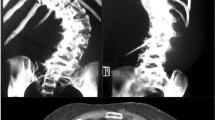Summary
The relationship between damage to particular brain stem nuclei related to postural control and equilibrium and the occurrence of spinal deformity has been investigated. The model used was the Wistar albino rat and the brain stem structures damaged were the gracillis nucleus, the superior colliculus and the lateral vestibular nucleus. Out of 60 brain stem damaged animals, 44 had accurate lesions from which 11 (25%) showed kyphoscoliotic deformities. Rats with spinal deformity showed an imbalance of the paraspinal muscles when assessed by EMG; this was expressed by an increase of muscular activity on the convex side. This study indicates that postural dysfunction caused by brain stem damage may induce kyphoscoliosis in experimental animals and could be one of the underlying mechanisms in the production of human idiopathic scoliosis.
Résumé
Ce travail étudie les rapports entre les lésions de certains noyaux du tronc cérébral dévolus au contrôle des postures et de l'équilibre et le développement des déformations du rachis. On a utilisé comme animal d'expérience le rat blanc Wistar et les structures lésées ont été le noyau gracile, la colonne blanche supérieure et le noyau vestibulaire latéral. Sur les 60 animaux d'expérience, 44 avaient subi des lésions bien localisées et 11 de ces derniers (25%) présentaient des déformations cypho-scoliotiques. L'électromyographie des rats porteurs de déviations rachidiennes montrait un déséquilibre au niveau des muscles spinaux, caractérisé par une augmentation de l'activité électrique du côté de la convexité. Ce travail montre qu'un dysfonctionnement du contrôle postural dû à une lésion du tronc cérébral est susceptible d'entraîner une cypho-scoliose chez l'animal. Ce peut donc être un des mécanismes étio-pathogéniques de la scoliose idiopathique humaine.
Similar content being viewed by others
References
Barrack RL, Whitecloud TS, Burke SW, Cook SD, Harding AF (1984) Proprioception in idiopathic scoliosis. Spine 9: 681–685
Barrios C, Tuñon MT, De Salis JA, Beguiristain JL, Canadell J (1987) Scoliosis induced by medullary damage: an experimental study in rabbits. Spine 12: 433–439
Forsberg H, Nashner LM (1982) Ontogenic development of postural control in man: Adaptation to altered support in visual conditions during stance. J Neurosci 2: 545–552
Herman R, Mixon J, Fisher A, Maulucci R, Stuyck J (1985) Idiopathic scoliosis and the central nervous system. A motor control problem. Spine 10: 1–14
Kawata S (1976) Experimental scoliosis produced by stereotaxic destruction of posterior part of the hypothalamus in bipedal rats. Shikoka Acta Med 32: 125 (in Japanese)
Liszka O (1961) Spinal cord mechanism leading to scoliosis in animal experiments. Acta Med Pol 2: 45–63
MacEwen GD (1973) Experimental scoliosis. Clin Orthop 93: 69–74
Mixon R, Steet H (1982) Oculomotor control in children with idiopathic scoliosis. Paper given at 17th annual meeting of Scoliosis Research Society, Denver, Colorado
Mountcastle VB (1980) Medical physiology. CV Mosby, St Louis, pp 374–388
Nashner LM (1976) Adapting reflexes controlling the human posture. Exp Brain Res 26: 59–62
Paxinos G, Watson C (1986) The rat brain in stereotaxic coordinates. Harcourt Brace Jovanovich Publishers and Academic Press, Sydney Orlando London
Pincott JR, Taffs LF (1982) Experimental scoliosis in primates: a neurological cause. J Bone Joint Surg (Br) 64: 503–507
Sahlstrand T, Ortengren R, Nachemson A (1978) Postural equilibrium in adolescent idiopathic scoliosis. Acta Orthop Scand 49: 354–365
Sahlstrand T, Petruson B (1979) A study of labyrinthine function in patients with adolescent idiopathic scoliosis. Acta Orthop Scand 50: 759–769
Sarwark JF, Dabney KW, Salzman SK, Wakabayashi T, Kitadail HK, Beauchamp JT, Beckman AL, Bunnel WP (1988) Experimental scoliosis in the rat I. Methodology, anatomic features and neurologic characterization. Spine 13: 466–471
Smith RM, Dickson RA (1987) Experimental structural scoliosis. J Bone Joint Surg (Br) 69: 576–581
Tamura T (1974) An experimental study on scoliosis in bipedal rats with brain stem lesion. J Jpn Orthop Assoc 48: 137 (in Japanese)
Tezuka A (1971) Development of scoliosis in cases with congenital organic abnormalities of the brain stem. Tokushima J Exp Med 18: 49–62
Wyatt MP, Barrack RL, Mubarak SJ, Whitecloud TS, Burke SW (1986) Vibratory response in idiopathic scoliosis. J Bone Joint Surg (Br) 68-B: 714–718
Yamada K, Ikata I, Yamamoto H, Nakagawa Y, Tanaka H, Tezuka A (1969) Equilibrium function in scoliosis and active plaster jacket for the treatment. Tokushima J Exp Med 16: 1–7
Yamada K, Yamamoto H, Nakagawa Y, Tezuka A, Tamura T, Kawata S (1984) Etiology of idiopathic scoliosis. Clin Orthop 184: 50–57
Yekutiel M, Robin GD, Yarum R (1981) Proprioceptive function in children with adolescent idiopathic scoliosis. Spine 6: 560–566
Author information
Authors and Affiliations
Additional information
This paper was presented in part at the Combined Meeting of the Scoliosis Research Society and the European Spinal Deformities Society, Amsterdam (The Netherlands), September 17–22, 1989
Rights and permissions
About this article
Cite this article
Barrios, C., Arrotegui, J.I. Experimental kyphoscoliosis induced in rats by selective brain stem damage. International Orthopaedics 16, 146–151 (1992). https://doi.org/10.1007/BF00180206
Published:
Issue Date:
DOI: https://doi.org/10.1007/BF00180206




